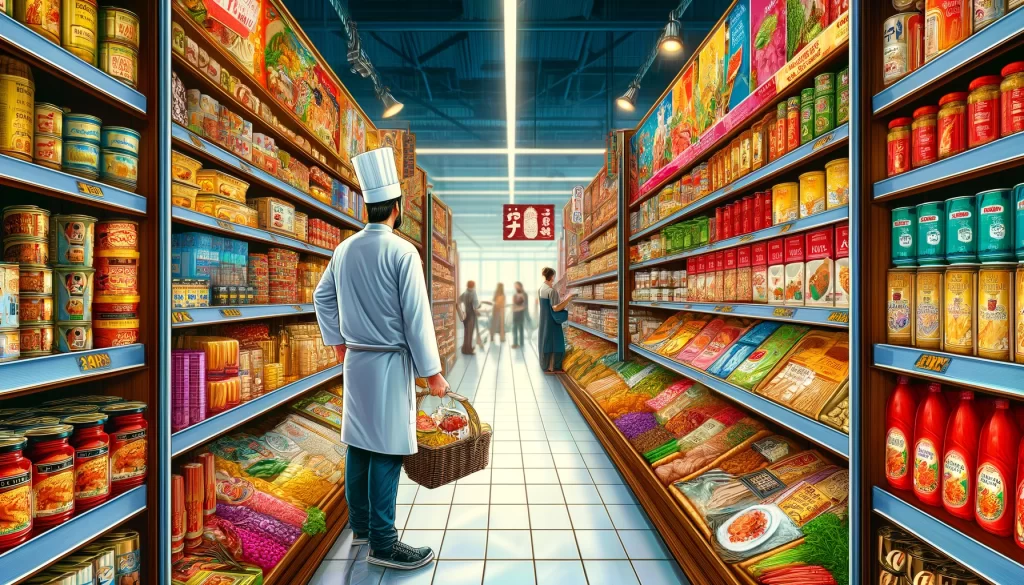Frankie Gaw, a Taiwanese American food creator, is gaining popularity for his unique approach to cooking by blending American classics with Asian flavors. His social media page, filled with imaginative creations like toasted sesame-flavored Cheerios, Pop-Tarts topped with strawberry lychee frosting, and Lunchables featuring fried pork gua bao, cucumber salad, and Yakult, offers items rarely found in typical American grocery stores. This concept forms the core of his cooking series, “Turning American Classics Asian.”
Origins and Inspiration
The inspiration for this cooking series began during a trip to Gaw’s local supermarket. As he traversed the aisles, he noticed that much of the food stocked on the shelves resembled what he saw as a kid 20 years ago. Meanwhile, ingredients like soy sauce and miso were still confined to “Asian” or “International” aisles. This observation led Gaw to ponder what an inclusive world with diverse flavors would look like. His background in Cincinnati, Ohio, where he experienced a mix of American and Asian foods, also played a significant role. Growing up, he felt like he was living a double life—enjoying McDonald’s chicken nuggets and fries in public while feasting on his grandmother’s beef noodle soup at home.
A Personal Journey
Gaw’s culinary journey is deeply personal. His father’s passing in 2014 from lung cancer prompted him to revisit family recipes as a way to honor his father and paternal grandmother. In his Seattle apartment, he began experimenting with his childhood favorites. He tinkered with Campbell’s cream of mushroom soup, turning it into congee, and infused mac and cheese with miso. He even designed packaging for each meal as if he owned a food company. Sharing these concoctions on social media, Gaw’s posts resonated with many, especially other Asian Americans. “It was a surprise. I didn’t realize how many people had similar experiences as me,” he said.

Cultural Blending
“Turning American Classics Asian” serves as a tribute to both American and Asian culinary traditions. Gaw aims to celebrate this blend and provide representation for Asian Americans. He reflects on his own feelings of being “in-between,” not fully fitting into either culture. By creating fusion dishes, he hopes to make this cultural blending more visible and accepted. “I have always straddled this sort of in-between space,” he said. “Growing up in the Midwest, I never felt Asian enough. But then, being with my Asian family, I didn’t feel American enough.”
Family and Community Impact
The series also highlights Gaw’s family memories, especially his mother’s efforts to help him fit in by stocking the pantry with popular American snacks like Lunchables, Twinkies, and Pop-Tarts. These efforts ensured he had the “best lunch” in the cafeteria. His version of a Happy Meal features steamed buns filled with ground pork, scallions, and ginger, topped with chili crunch ketchup. Late-night McDonald’s drive-through visits with his parents, who often worked long hours, were a common occurrence. These experiences shaped his appreciation for both American and Asian cuisines.
As Gaw cooks, he thinks about his father, his mother, his grandparents, and the comfort these dishes would have brought them as they adjusted to life in America. “I think they always felt like they were on the outside breaking in,” he said. “To see their food at a fast food institution, I think it would’ve made them feel like they have a seat at the table.”
This article is based on the following article:
https://www.npr.org/2024/05/29/g-s1-1284/food-turning-american-classics-asian-frankie-gaw

Background Information
1. Taiwanese American Identity:
- Taiwanese American refers to people who are of Taiwanese descent and live in the United States. Taiwan is an island nation in East Asia, known for its rich cultural heritage and unique cuisine that blends influences from China, Japan, and indigenous Taiwanese cultures. Taiwanese Americans often bring their culinary traditions with them, enriching the American food landscape.
2. Social Media Influence on Food Culture:
- Social Media Platforms such as Instagram, YouTube, and TikTok have become significant in shaping food trends. Chefs and home cooks share recipes, cooking tips, and food photography, influencing millions of followers. These platforms allow food creators to reach a broad audience quickly, making it easier to introduce new culinary ideas and cultural fusions.
3. American Classic Foods:
- Cheerios are a popular breakfast cereal in the United States, typically made from whole grain oats.
- Pop-Tarts are a type of toaster pastry that comes in various flavors, often frosted, and are a common breakfast or snack item.
- Lunchables are pre-packaged lunch combinations, usually including items like crackers, cheese, meats, and sometimes a small dessert or drink. They are popular among children and convenient for school lunches.
4. Asian Ingredients and Flavors:
- Soy Sauce is a liquid condiment made from fermented soybeans and wheat, commonly used in East Asian cuisine.
- Miso is a traditional Japanese seasoning produced by fermenting soybeans with salt and kōji (a type of mold). It is often used in soups and sauces.
- Lychee is a tropical fruit with a sweet, aromatic flavor, often used in desserts and drinks.
- Matcha is a finely ground powder of specially grown and processed green tea leaves, traditionally consumed in East Asia and used in a variety of recipes.
5. Cultural Blending and Fusion Cuisine:
- Cultural Blending in cuisine occurs when elements from different culinary traditions are combined to create new dishes. Fusion cuisine often reflects the multicultural backgrounds of the cooks and the diverse societies they live in. It celebrates the merging of different culinary practices and ingredients.
6. The Role of Food in Immigrant Identity:
- For many immigrants and their descendants, food is a vital connection to their heritage. It serves as a reminder of their homeland and a way to preserve their cultural identity. Cooking traditional dishes and incorporating new ingredients from their new home country can help immigrants feel more connected to both cultures.
7. Culinary Terminology:
- Congee is a type of rice porridge commonly eaten in many Asian countries. It can be served plain or with various toppings and ingredients.
- Boba Tea (also known as bubble tea) is a tea-based drink that originated in Taiwan. It includes chewy tapioca balls (“boba”) and comes in various flavors.
- Gua Bao is a type of Taiwanese sandwich that consists of a steamed bun filled with braised pork belly, pickled mustard greens, and other condiments.
8. The Midwest of the United States:
- The Midwestern United States includes states like Ohio, where Gaw grew up. This region is known for its diverse population, strong agricultural industry, and a mix of urban and rural communities. The culinary traditions here often include comfort foods and dishes influenced by various immigrant groups.
9. American Fast Food Culture:Fast Food Chains like McDonald’s are a significant part of American food culture. They offer quick, convenient meals and are known for items like burgers, fries, and chicken nuggets. Fast food is often associated with busy lifestyles and the need for convenience.

Debate/Essay Questions
- How does food play a role in shaping and expressing cultural identity, particularly for immigrants and their descendants?
- Should there be more effort to integrate international foods into the general aisles of American grocery stores rather than segregating them into “ethnic” sections?
- Do fusion dishes like those created by Frankie Gaw help in making American cuisine more inclusive, or do they risk oversimplifying and commodifying cultural foods?
Please subscribe to Insight Fortnight, our biweekly newsletter!
